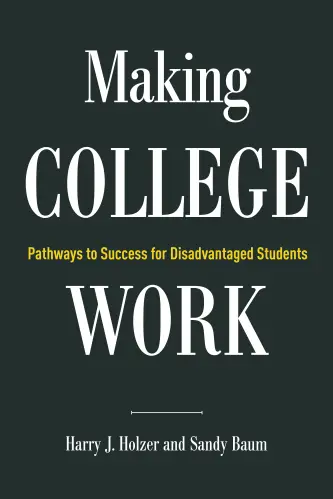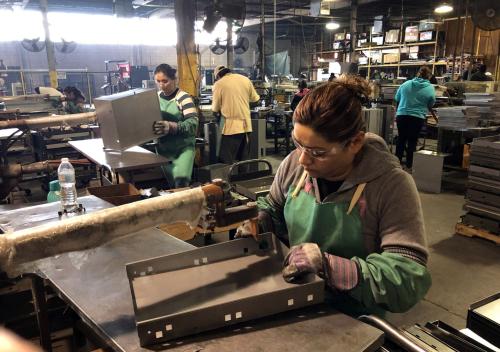The Higher Education Act (HEA) is the primary law through which the federal government regulates and helps finance postsecondary education in the United States. Title IV, in particular, authorizes Pell grants for poor students and myriad other grant and loan programs (as well as work-study); other titles provide aid to colleges and universities, especially those serving mostly minority and/or disadvantaged students. As Congress prepares to reauthorize HEA, many issues regarding how the federal government can best improve access of all students to higher education, while improving student outcomes like credential attainment and subsequent earnings, are being debated.
In this brief, I consider one such issue: how to strengthen workforce and occupational programs in U.S. higher education, and thereby improve the future employment outcomes of low-income students. I define these programs broadly to include certificate programs at community and for-profit colleges as well as occupational degree programs there (in health care, business, and other fields) at the associate degree level. Since only students in for-credit programs at accredited institutions currently qualify for financial aid under Title IV, these certificate and degree programs are what I primarily focus on.
The Barriers to Greater Attainment of High-Value, Sub-BA Credentials
Students pursuing workforce occupational credentials – including both young and nontraditional older students – often do so at the sub-BA levels, at community and for-profit colleges. In doing so, they face many challenges.
For one thing, credential completion rates in institutions are very low, averaging 30-40 percent.[1] Furthermore, while some of these sub-BA degrees and certificates generate strong earnings in the labor market (Jepsen et al., 2014; Backes et al., 2015; Stevens et al., 2018), many students emerge with terminal credentials (such as associate degrees in “liberal studies” or “general studies”) that have little labor market value, relative to a high school degree.2 And, though debt levels among these students are lower than for those in BA and graduate programs, their default rates are relatively high, especially among those not completing a credential (Holzer and Baum, op. cit).
Academic research (e.g., Bound et al., 2010) suggests that a number of problems, reflecting characteristics both of students and the institutions they attend, now limit their ability to complete programs and obtain high-value credentials. Regarding students, many come from disadvantaged families where they are the first generation to attend college. Their basic academic skills are often weak (requiring remediation). Too many must work full-time to support families while attending college, and often struggle with child care and other needs. Many also lack basic information about which colleges to attend and how to succeed once they get there, making poor choices about what to study and sometimes wandering aimlessly in the process (Scott-Clayton, 2011).
To take one example, as many as 85 percent of traditional (younger) students enter community college believing they will transfer and ultimately obtain a BA, so they take mostly liberal arts classes somewhat aimlessly; in fact, only about 14 percent successfully transfer and obtain a BA (Holzer and Baum, 2017). With better guidance and more information about their own prospects as well as the market value of different credentials, one can imagine that many would choose fields of study more realistically, generating higher completion rates and more labor market value than now.
Regarding institutions, community colleges receive too few resources from states, relative to four-year colleges and universities (The Century Foundation, op. cit.).[3] But they also face too few incentives to respond to labor market signals. Their state subsidies depend primarily on enrollment, not completion of credentials or labor market value; and most faculty want to teach liberal arts, despite the fact that these degrees have low market value. And instruction in some of the “in-demand” technical fields is quite expensive, both due to instructor and equipment costs. Accordingly, there are few incentives for community colleges to spend their very limited resources in ways that expand teaching capacity in health care and other in-demand fields.
In contrast, the various for-profit schools are less bureaucratic and more responsive to shifts in labor market demands for skills. But they charge vastly higher tuition than their public counterparts, creating high levels of debt and default rates among students, while generating credentials that are sometimes not valued as seriously by the labor market as those from traditional institutions (Deming et al., 2014; Cellini et al., 2017). They also consume disproportionately high levels of Title IV funding for low-income students.
There are other approaches to workforce development at community colleges that appear successful in rigorous evaluations. For instance, sector-based partnerships between employers and community colleges in high-demand fields (like health care, information technology, advanced manufacturing and transportation/logistics) often lead to degrees and certificates that have strong market value, creating large positive impacts on the subsequent earnings of disadvantaged students (Maguire et al., 2010; Elliott and Roder, 2019).[4] In response to this evidence, the partnerships that create such programs have proliferated, but they often remain at too small a scale to meaningfully improve opportunities for disadvantaged students and workers.
Apprenticeships create another pathway to credential attainment with market value. Apprenticeships generate strong earnings for workers who complete them, while allowing employers to train workers for the skills they need. They also solve at least some of the problems noted above, like the high costs of equipment for community colleges, since much instruction and use of equipment is on the job.
Apprenticeships generate strong earnings for workers who complete them, while allowing employers to train workers for the skills they need.
But employer willingness to provide apprenticeships, and to partner more generally with education providers, remains quite low and successful efforts lack scale. The reasons are likely many – lack of information on how to set them up, high start-up costs, exaggerated fears of costs and “red tape,” and fears of “poaching” by other employers (Lerman, 2018).
As much as possible, HEA reauthorization should address these many barriers to higher rates of credential attainment in high-demand occupations and sectors. To achieve the general goals of more credential attainment in high-demand fields, I argue that we should strive to strengthen guidance (and other supports) for community college students, provide more resources for the colleges but also stronger incentives to respond to the labor market, and fund more partnerships and training opportunities with employers.
What Has Been Proposed to Date: PROSPER and AIM HIGHER
In 2017 and 2018, both Republicans and Democrats in the House of Representatives separately drafted proposed reforms to HEA, entitled PROSPER and AIM HIGHER respectively. Both proposals purport to strengthen occupational and workforce programs in public and for-profit institutions.
PROSPER aims to improve credential completion overall by streamlining financial aid and regulation of higher education programs, and by encouraging innovation in such programs.[5] Regarding workforce programs, it would lower the required credit hours and weeks needed for certificate programs to be eligible for Title IV funding from 600 hours and 15 weeks currently to 300 and 10 respectively. This would open federal financial aid to students in many shorter-term certificate programs, as long as evidence of labor market value is provided.
PROSPER would also dramatically limit current regulations on for-profit institutions. For instance, it would eliminate the “90/10” rule that currently requires these institutions to generate at least 10 percent of their funding outside of federal financial aid; and it would also drop the “Gainful Employment” regulations protecting student outcomes in occupational and for-profit programs, replacing them only with the provision of more data on such outcomes.[6] It would also make it much easier for a range of new institutions to become accredited, by granting waivers to accreditors and shortening the time periods under which institutions can undergo federal review.
PROSPER also would completely replace Title II grants (to enhance teacher quality) with a program to fund apprenticeships. This program would skirt the current regulations associated with registered apprenticeship and gives industry-wide latitude for designing and implementing them with federal funding.
Some aspects of PROSPER are appealing. It would expand the numbers of certificate programs in which disadvantaged students could receive financial aid. It would undoubtedly generate many newly accredited occupational training institutions and programs, some of which would be of high quality.
But the track record of the for-profit sector to date does not merit a dramatic reduction in regulation, to put it mildly. Making it easier for many new private programs to gain accreditation could generate many more such for-profit ventures, with fairly negative outcomes similar to those we now observe.
Perhaps the apprenticeship proposal will appeal to employers, and make them more interested in setting up such programs. At the same time, the proposal opens the floodgates for programs that might differ substantially from the registered model that now appears so cost-effective (Reed et al., 2012).
In contrast, AIM HIGHER seeks to expand targeted funding for many disadvantaged students and institutions, strengthen accountability standards for occupational programs and proprietary schools more generally, and encourage more states to offer free community college. It would expand funding for childcare and other necessary supports on campuses, and would generate a new competitive grant program (called “Student Success”) to help strengthen support services (including guidance) at under-resourced institutions.
Regarding occupational programs, AIM HIGHER would limit the current hour and week regulations for certificate programs to achieve Title IV eligibility by more than PROSPER (to 150 hours and 8 weeks respectively), while providing more oversight of program outcomes. It would strengthen regulation of for-profit institutions and accountability of occupational programs more broadly in a variety of ways, such as changing the “90/10” rule to “85/15.”[7] It would also allow and encourage more work-based learning in its Career and Technical Education (CTE) programs and Federal Work Study (FWS).
AIM HIGHER would undoubtedly expand access to college for disadvantaged students and generate more resources for some institutions. But I fear its provisions are too limited to have great impact on occupational programs. Specifically, I worry that:
- Making apprenticeships or other work-based learning “allowable” in CTE or FWS will increase their numbers by fairly little, since they are costly to set up; institutions will still be incentivized to do what’s easier, such as more traditional campus-based jobs.
- The competitive grants in “Student Success” and other HEA programs will generate needed supports for some institutions, but they will reach only small numbers of students and will not provide sustainable funding over time.
- Reforming accreditation or changing the “90/10” rule to “85/15” only affects the lower bound of desired performance, and does not incentivize the stronger changes we need.
At the same time, both PROSPER and AIM HIGHER currently have relatively little to say about two of the most influential and potentially powerful reforms that many states and community colleges are embracing to improve their outcomes: outcome-based funding (where states use outcomes of institutions to determine their funding levels) and guided pathways.
Over 30 states now use some version of outcome-based funding for public higher education (National Conference of State Legislators, 2019). I believe the most promising models are those that reward schools for employment outcomes as well as credential completion, that statistically adjust for the limited preparedness of many entering students (to deter “creaming” in admissions which would hurt the disadvantaged), and especially those that explicitly reward institutions for enrolling more minority or disadvantaged students and improving their outcomes (which are called “equity measures” by Cielinski and Pham, 2017). Since most states are using some version of OBF, it is important for reauthorized HEA to influence these efforts in a positive way. We also need more evidence of exactly what works and for whom in these efforts (Deming and Figlio, 2016; Dougherty, 2017).
Regarding guided pathways, there has been much institutional interest since Bailey et al. (2015) was published. But, once again, current evidence is too limited on what works, and many institutions need more resources to implement these changes effectively.
Interestingly, much of the career guidance that students need is already provided at about 2500 American Job Centers (formerly known as One-Stops). Leveraging the widespread availability of these services at such centers might prevent the need for community colleges to reinvent this wheel on their own.
My Proposals
I propose a set of amendments to HEA that would:
- Make academic and career guidance to community college students much more widely available than they are now;
- Provide more targeted resources for “in-demand” occupational programs plus support services at community colleges, but also generate stronger incentives for colleges to expand occupational programs, especially in ways that benefit minority and disadvantaged students; and
- Expand employer creation of apprenticeship and other forms of engagement with or support for community or four-year colleges.
1) To make academic and career guidance more available, I would:
- Create a competitive grant program for community colleges to build and evaluate “guided pathways” to improve both credential completion and transfer rates to four-year institutions; and
- Create a formula fund to pay for more academic/career counseling and “navigators,” at an average of $100,000 per college, either on campus or at local American Job Centers, for each community college where minority or low-income students constitute a majority of those enrolled.[8]
The competitive program to expand and evaluate “guided pathways” would help community colleges implement this important new reform proposal, while we learn the extent to which it is cost-effective. The formula grant would ensure that community colleges serving large numbers of minority or disadvantaged students have the resources to provide them with academic and career guidance, which should improve their outcomes as well.
2) To provide targeted resources to in-demand occupational (including both degree and certificate) programs and related supports, while also strengthening incentives for community colleges to expand these:
- Create a major competitive matching grants to states for expanding teaching capacity in high-demand fields plus support services, conditional on their use of some outcome-based funding for community colleges (and maybe 4-year colleges), in ways that emphasize employment outcomes, especially among minority and disadvantaged students without generating “creaming”;[9] and
- Provide resources to evaluate outcome-based funding formulas that states are already using.
These funds would help steer the outcomes-based reforms that so many states are implementing towards those that best serve minority and disadvantaged students. At the same time, they would also spur evaluations to inform us about the extent to which these reforms work without generating adverse consequences.
3) To expand employer creation of apprenticeships and other modes of sector-based partnership with community colleges:
- Create a formula fund for states to provide resources and technical assistance to both employers and community colleges, and sector-based partnerships between them, which could be integrated into state workforce plans to encourage more sector-based training and apprenticeships;[10] and
- Reward institutions with additional funding if at least some minimal percentage of their resources are provided by tuition payments from employers.[11]
The new formula fund would provide more resources to states as they seek to scale up sector-based training and apprenticeships with local employers. And the rewards for institutions that successfully engage employers will hopefully encourage more such cooperation between community colleges and local industry.
Conclusion
As Congress wrestles with how to reauthorize HEA, both Republicans and Democrats have expressed a desire to strengthen workforce programs in higher education, especially at community and for-profit colleges and universities.
But neither of their proposals does enough to expand support and accountability in ways that would matter the most: by providing more guidance to students, by raising both institutional funding and incentives to improve employment, and by directly funding more registered apprenticeships and sector-based training partnerships between employers and community colleges.
Above I lay out a set of proposals to do that. I hope these provide some basis for an ongoing conversation about how best to use HEA reauthorization to improve the skills and earnings of disadvantaged American students.
REFERENCES
Backes, Benjamin; Harry Holzer and Erin Velez. 2015. “Is it Worth It? Postsecondary Education and Labor Market Outcomes for the Disadvantaged.” IZA Journal of Labor Policy, 4(1).
Bailey, Thomas; Shanna Jaggers and Davis Jenkins. 2015. Redesigning America’s Community Colleges. Cambridge: Harvard University Press.
Bound, John et al. 2010. “Why Have College Completion Rates Declined? An Analysis of Changing Student Preparation and Collegiate Resources.” American Economic Journal: Applied Microeconomics. 2(3).
Cellini, Stephanie et al. 2017. Gainful Employment Regulations Will Protect Students and Taxpayers. Don’t Change Them. Brookings Brief, Economic Studies, Washington DC.
Century Foundation. 2019. Restoring the American Dream: Providing Community Colleges with the Resources They Need. Report of the Working Group on Community College Financial Resources. New York: The Century Foundation Press.
Cielinski, Anna and Duy Pham. 2017. EQUITY MEASURES IN STATE OUTCOMES-BASED FUNDING: Incentives for public colleges to support low-income and Underperforming Students. Center for Law and Social Policy, Washington DC.
Deming, David and David Figlio. 2016. “Accountability in US Education: Applying Lessons of K-12 to Higher Education.” Journal of Economic Perspectives. 30(3).
Deming, David and Christopher Walters. 2017. “The Impact of Price Caps and Spending Cuts on US Postsecondary Attainment.” National Bureau of Economic Research Working Paper.
Deming, David et al. 2017. “The Value of Post-secondary Credentials in the Labor Market: An Experimental Study.” American Economic Review 106(3).
Dougherty, Kevin et al. 2016. Performance Funding for Higher Education. Baltimore: Johns Hopkins University Press.
Elliott, Mark and Anne Roder. 2019. Nine-Year Gains: Project Quest’s Continuing Impacts. New York: Economic Mobility Corporation.
Holzer, Harry and Sandy Baum. 2017. Making College Work: Pathways to Success for Disadvantaged Students. Brookings.
Jepsen, Christopher et al. 2014. “The Community College Returns to Degrees, Diplomas and Certificates.” Journal of Labor Economics. 32(1).
Lerman, Robert. 2018. ”Restoring Opportunity by Expanding Apprenticeship.” Urban Institute, Washington DC.
Maguire, Sheila et al. 2010. Tuning Into Local Labor Markets. Public-Private Ventures, Philadelphia PA.
National Conference of State Legislatures. 2019. “Performance Based Funding for Higher Education.” http://www.ncsl.org/research/fiscal-policy/performance-based-funding-for-higher-education.aspx
Shireman, Robert. 2019. Testimony to the (Maryland) House Appropriations Committee on HB464: Private Career Schools and For-Profit Institutions of Higher Education – Disclosures and Regulation, February 12.
Stevens, Ann Huff; Michal Kurlaender and Michel Grosz. 2019. “Career and Technical Education and Labor Market Outcomes: Evidence from California Community Colleges.” Journal of Human Resources, 54(2).
The Brookings Institution is committed to quality, independence, and impact.
We are supported by a diverse array of funders. In line with our values and policies, each Brookings publication represents the sole views of its author(s).







